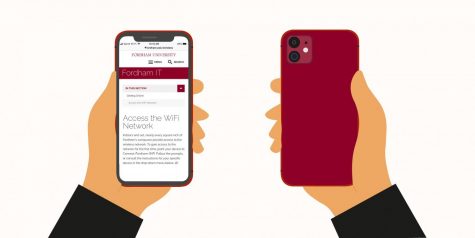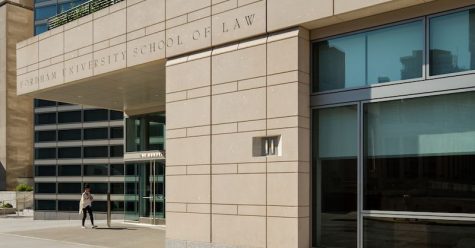Nano-Medicine and Technology Lab Seeks to Heal Neural Cells
Eliot Schiaparelli/The Fordham Ram
Rachel Daso provided a research update to her lab group titled "Peptides, Ions and Cells, Oh My!"
October 30, 2019
Whether through trauma, disease or tissue damage, the loss of neural cells in the brain is nearly impossible to reverse, but that is what Rachel Daso, FCRH ’21, Margaret Whalen, FCRH ’21, and Dr. Ipsita Banerjee, Ph.D., are trying to do in their bio-nanotechnology and nano-medicine lab.
At a meeting of their lab group, Banerjee told her students the goal for all their projects is publication.
“All the work that you’re doing is graduate-level work,” she said. “We’re trying to publish this. You’re essentially competing with Ph.Ds from all over the world. It’s not just undergraduate work where you’re learning techniques.”
Members of the lab work on cell scaffolding and tumor targeting via nanotechnology.
They are focused on biocompatible compounds that are derived from things in the body or similar to things present in the body making them safer for the surrounding cells.
Daso has been working in the lab since the spring semester of her sophomore year, a step toward her goal of going to medical school. She started out on a project about tumor targeting and moved to her current project, creating cell scaffolds using peptides and ionic liquids.
“I wasn’t trying to get into this lab when I found it,” said Daso. “She was like, ‘Well, would you like to start working in my lab to actually see the connections between all the stuff you’re learning in your chemistry classes and humans?’”
Daso and Whalen hope to present the cell scaffold project at the American Chemistry Society conference.
“I feel like I’ve learned more about biochemistry being in the lab,” said Daso. “That’s when you really realize how all these things that you’re learning in your classes actually apply to the real world. It’s a great learning experience beyond doing it for a resume or for the discovery.”
While doing her summer research in tumor targeting, Daso said she noticed some unique properties in ionic liquids, which are used more for environmental chemistry than biochemistry.
Daso explained, that these liquids have a few cellular applications, but normally they’re very toxic.
However, when they are coupled with peptides, they are less toxic, and her lab thinks they may have medicinal uses.
“That’s when I started talking to Dr. Banerjee about how I wondered what we can do with these ionic liquids, and we both, at the same time, said they conduct electrochemical signals,,” said Daso. “Let’s try something Neural cell-based. I had been interested in neurology before so to be able to apply what I learned was very cool.”
As the most senior member of the lab, Daso often teaches newer members how to use machinery. She and her lab mates also rely on each other to help with projects making the atmosphere collaborative.
The specific area of cell scaffolding is an emerging technology. In practical use, one would place the scaffold at the area of injury so that cells could regenerate and then degrade leaving the body repaired.
So far, Whalen and Daso have created the scaffold bases and are testing their properties to see how they will affect cells. They measure thermal, mechanical and viscous properties. They also compare the area outside of the cells where the scaffold would theoretically be placed, using a scanning electron microscope.
“We are trying to create a neural scaffold,” said Daso. “Even if you go in with surgery to try to prevent more damage, the regeneration is a really big issue so there have been advances in the field to use nano-scale scaffold that can encourage neural cell regeneration.”
In the long term, they may be able to test their scaffolds in rats and even apply for a patent if they get impressive results, but for now, they are focusing on presenting and publishing.
Whalen and Daso will publish together. Each is looking at different ionic liquids made by Lincoln
Center faculty member Marie Thomas, Ph.D., to see if they have different mechanical properties.








If you want a picture to show with your comment, go get a gravatar.